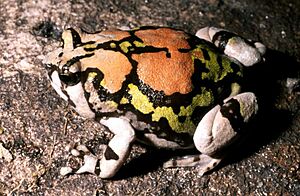Rainbow burrowing frog facts for kids
Quick facts for kids Rainbow burrowing frog |
|
|---|---|
 |
|
 |
|
| Two variants; the exact colour hue and pattern varies in this species | |
| Conservation status | |
| Scientific classification | |
| Genus: |
Scaphiophryne
|
| Species: |
gottlebei
|
The Scaphiophryne gottlebei, also known as the Malagasy rainbow frog, is one of the most colorful frogs from Madagascar. This amazing frog has bright patterns that make it stand out. Sadly, it is an endangered animal. Its biggest problems are losing its home and being caught for the pet trade. Luckily, catching them for pets is now against the law.
Contents
About the Rainbow Burrowing Frog
The Malagasy rainbow frog is a small, round frog. It has very bright colors and a special pattern on its back. This pattern includes clear areas of white, orange-red, green, and black. Its back skin is smooth, but its grey belly is a bit rough.
Its snout, or nose area, is rounded. Its eyes stick out, but its eardrums are hard to see. The frog has short, strong legs. Its front feet have large tips, and its back feet are webbed. This frog is good at both digging underground and climbing. It has tough bumps on its back feet to help it burrow. It also has claws on its front feet to hold onto vertical canyon walls.
Female frogs are usually bigger than males. Females grow to be about 1 to 1.6 inches (2.6 to 4 cm) long. Males are a bit smaller, growing to about 0.8 to 1.3 inches (2 to 3.4 cm) long.
Where Rainbow Frogs Live
The Malagasy rainbow frog lives only in the Isalo Massif mountains. This area is in the central part of southern Madagascar. It lives at heights of about 2,300 to 3,300 feet (700 to 1,000 meters). This includes the Isalo National Park and areas nearby.
Its main home is in narrow canyons. These canyons are usually cool, dark, and very humid. There is not much plant life there. The temperature in their home is usually between 66 and 72 degrees Fahrenheit (19 to 22 degrees Celsius). However, it can range from about 55 to 95 degrees Fahrenheit (13 to 35 degrees Celsius).
This frog shares its home with another colorful frog, the blue-legged mantella. That frog also needs protection. The rainbow frog digs into sandy areas near streams. It also spends time in small holes or cracks in rock walls. At night, it might climb several feet high on the rock walls. Sometimes, it can be found in open rocky areas, especially in dry forests.
Life Cycle and Behavior

The Malagasy rainbow frog breeds very quickly, all at once. This happens in November and December. It starts right after the first heavy rain of the wet season. Groups of many frogs, often more males than females, gather to breed.
Males call from rock walls or from the surface of temporary pools of water. The eggs are laid in these pools. The eggs hatch into tadpoles in about three days. These tadpoles have a round body and a flat underside. They look black during the day but turn brownish-grey at night.
In the wild, tadpoles eat tiny bits of dead plants and animals. They also filter food from the water. They have a special habit: during the day, they keep their heads in the sand at the bottom of the water. Their tails stick up at an angle. At night, the tadpoles swim around. They seem to filter tiny particles from the open water. Many tadpoles get washed away by strong water currents during the rainy season. They might finish changing into frogs somewhere else.
Young frogs that have just changed are about half or one-third the size of adult frogs. But they look very similar. Adult frogs can also move to new areas, especially when the weather is cold. These frogs usually live for only about 2 years.
Protecting the Rainbow Frog
The IUCN (International Union for Conservation of Nature) lists the Malagasy rainbow frog as "Endangered". It used to be listed as "Critically Endangered" from 2004 to 2008. But scientists found it was more widespread and common in some places than they first thought. Even though it is common in some areas, it lives in a small region. Its numbers are believed to be going down.
The main threats to this frog are losing its home and being taken too much for the pet trade. Its home is threatened by people cutting down trees, fires, animals eating too much grass, and mining. Tourists might also disturb their habitat. In the 2000s, thousands of these frogs were caught each year for the pet trade.
To help protect them, the frog was added to CITES Appendix II. This meant rules were made to limit how many could be taken. By 2014, the limit was set to zero. This made it illegal to export wild-caught frogs. There are signs that a snake called Leioheterodon modestus might be an important natural predator of this frog.



